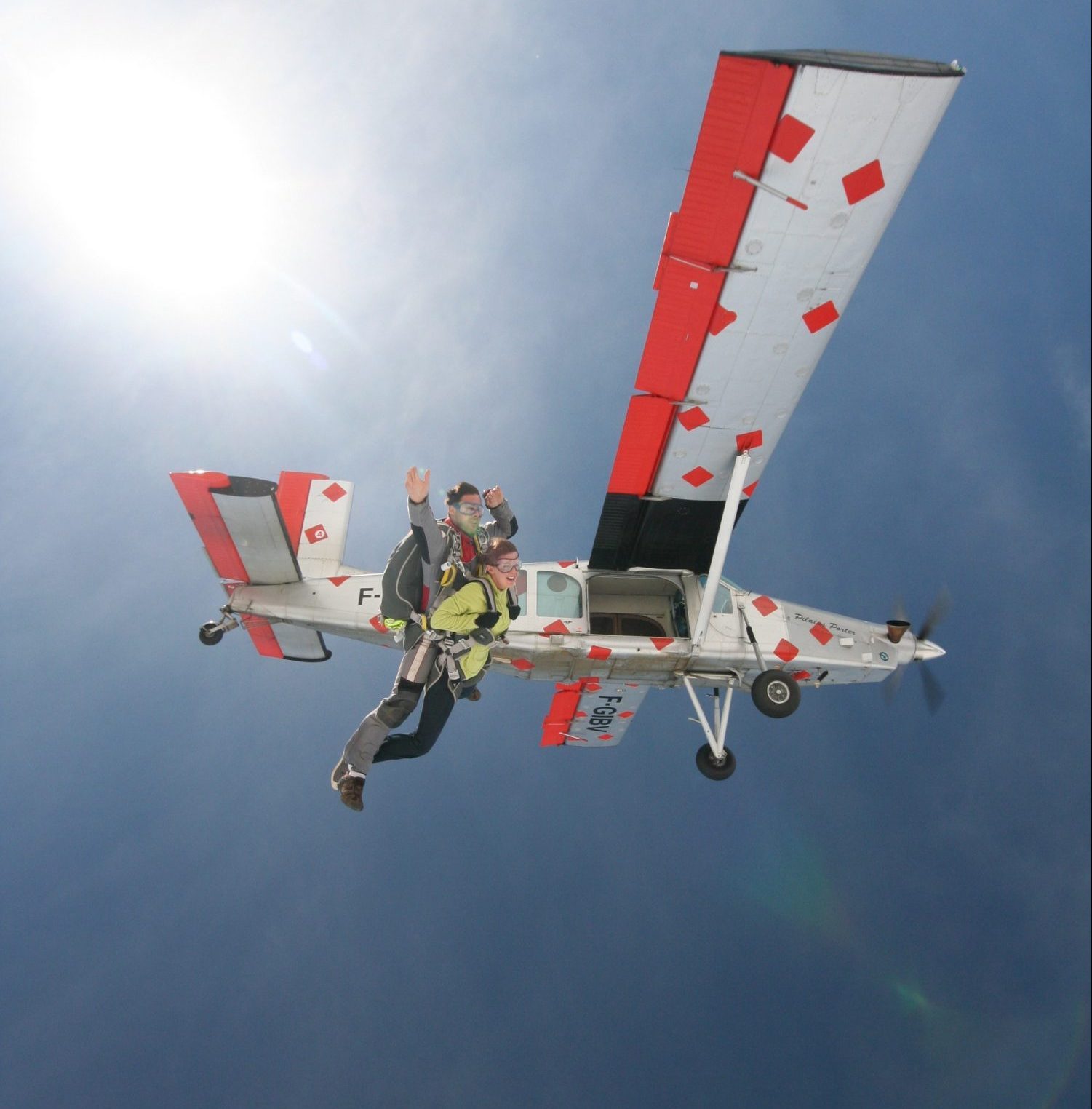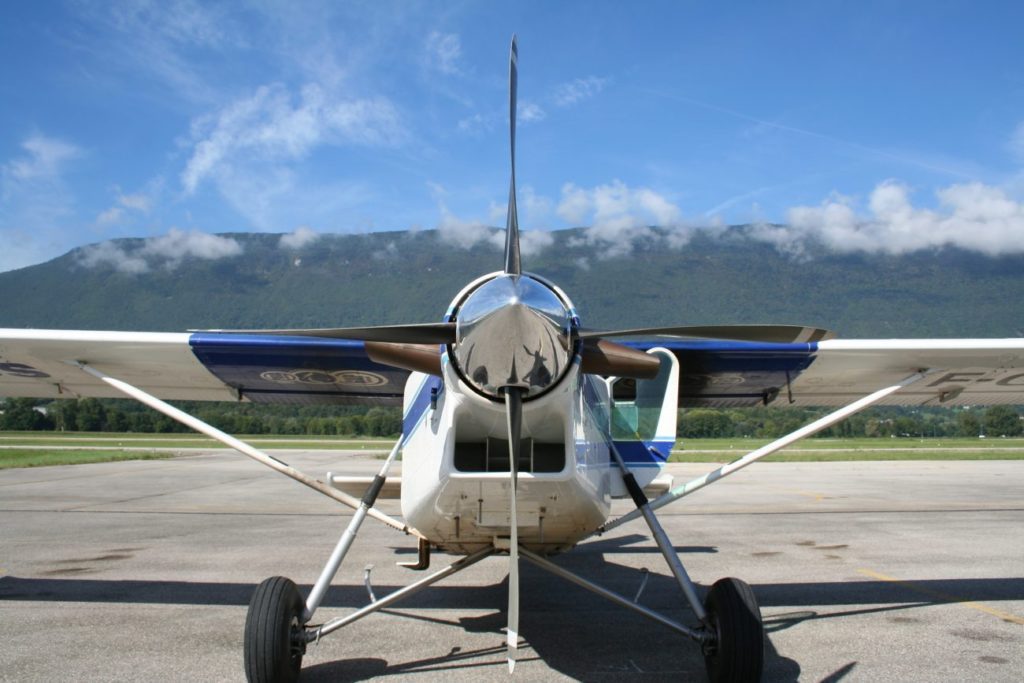
PILATUS PC6 class rating & skydiver dropping
Pilatus PC6 history
The Pilatus PC-6 is a high-wing short take-off and landing (STOL) utility aircraft built by the Swiss company Pilatus Aircraft.
It first flew on May 4, 1959 with aLycoming piston engine.
With remarkable handling performance, the prototype called Yeti, took part of the Swiss expedition that made the first ascent of the Dhaulagiri in the Himalayas in March 1960. He demonstrated his usefulness there and was led to reach plateaus at an altitude of 5,700m where the limits of motorization were felt.
With him, pilots Ernst Saxer and Emile Wick set the unmatched record for landing at the highest altitude with a fixed-wing aircraft at 5,750 metres. After 16 refueling flights till 4 May, they landed at the North Pass at an altitude of 5,700 meters on 5 May 1960. During takeoff, the Porter was severely damaged and was left there. Its carcass is still present on the scene at an altitude of 5,200 meters (source Wikipedia)

Mountain-friendly aircraft, Pilatus PC6 was for a long time associated to AIR ALPES, which used it for most of its activity (drop-off skiers on glaciers, commercial flights to mountain, etc.) especially from the Courchevel Altiport.
Thanks to the adaptation of a turboprop, the PC-6 becomes the PC-6A Turbo-Porter. It made its first flight on 2 May 1961 equipped with a Turbomeca Astazou turbine of 523 hp. The PC-6B version is fitted with a Pratt & Whitney Canada PT6A-6, this version made its first flight in May 1964.
Nowadays in civilian life, it is widely used for parachute dropping activity It can carry 9 skydivers in it B2H2 version and 10 in its B2H4 version.
It is used in many skydiving centers in France.
Specifications
- Engine: A 550 hp (404 kW) Pratt & Whitney Canada PT6A-27 Turboprop;
The PT6A-27 engine is the most common one. However some PC6 are equipped with a PT6A-34 or less common, a PT6A-20.
- Propeller: Hartzell three-bladed aluminum, with a diameter of 2,67 m (four blade propeller optional)
- Aircraft length: 10.90 m
- Height: 3.20m
- Wing length: 15.87 m
- Wing area: 30.15 sqm
- Wing load: 41.46 kg/m2
- Cabin: more than 3m3, 10 passengers or a ton of payload
- Doors: 2 of which 1 or 2 sliding doors
- Empty weight: approx. 2,756 – 3,086 lb (1250 -1400KG)
- Maximum take-off weight: 6,173 lbs(2,800 kg);
- Maximum landing weight: 5,863 lbs 2,660 kg ) ;
- Maximum payload: 2,646 lbs (1200 kg)
- Payload with maximum fuel: 2,381 lbs (1080 kg)
Performance
- Takeoff distance to clear a 50 ft (15 m) obstacle: 1,444 ft (440 m);
- Landing distance to clear a 50 ft(15 m) obstacle: 1,033 ft(315 m) ;
- Rate of climb: 1,010 ft/min (307.8 m/min) ;
- Maximum cruise speed: 125 KTAS (232 km/h)
- Maximum range 10,000 ft: 500 nautical miles (926 km);
- with additional tanks under the wings: 870 nautical miles (1,611 km).
- Practical ceiling: 25 000 ft (7 620 m)
- Stall speed (MTOW): ;
- Landing flaps retracted (Vs): 58 KEAS (107 km/h);
- Landing flaps fully extended (Vso): 52 KEAS (96 km/h)
- Max load factors : + 3.5 / -1.43 g
- Cruising speed at 3 000 m : 250 km/h
- Initial climb speed at 2000 kg: 518 m/min or 8.63 m/s
- Flight Capabilities: Full load climb at 4000 m in ~15 min, descent in less than 3 min ;
Variants
Pilatus Porter (piston engine version) :
- PC-6 Porter : powered by an Avro Lycoming GSO-480-B1A6 (340 hp), first flight on May 5th 1959 (HB-FAN), 64 built
- PC-6/275: prototype powered by a Lycoming GSO-480-B1A6 (260 hp), first flight on May 2, 1960 (HB-FAS), 1 built.
- PC-6/350: powered by a Lycoming IGO-540-A1A (350 hp), first flight on January 12, 1961 (HB-FAG), 8 built.
Pilatus Turbo Porter (turbine version)
- PC-6/A Turbo-Porter: Powered by Turbomeca Astazou IIE (523 hp)/ G, first flight on 5 February 1961 (HB-FAD), 35 built.
- PC-6/A1: Powered by Turbomeca Astazou XII (573 hp), first flight on 5 May 1967 (HB-FCT), 6 built.
- PC-6/Ax-H2: Powered by a Turbomeca Astazou X prototype (573 hp), first flight in 1964 (F-BKQU), modified PC-6A, converted to PC-6/A1-H2.
- PC-6/A2: Powered by a Turbomeca Astazou XIVE (573 hp), first flight in September 1967 (F-BOSZ), 1 built
- None of the PC-6/A are in service anymore.
- PC-6/B: Powered by a Pratt & Whitney Canada PT6-6A (550 hp), first flight on May 2, 1964 (N187H), 12 built.
- PC-6/B1: Powered by a Pratt & Whitney PT6A-27 (680 hp), first flight on 18 May 1966 (HB-FCD), 82 built plus 12 Fairchild Aircraft.
- PC-6/B2 : motorisé par un Pratt & Whitney PT6A-27 (680 ch) , premier vol le 9 mai 1984 (HB-FCD), 252 construits plus 18 de Fairchild Aircraft.
- PC-6/B2(STC): Powered by a Pratt & Whitney PT6A-34 (750 hp), first flight in May 2001 (F-GODZ), 28 converted or built.
- Approximately 256 PC-6/B out of 373 were still in service in 2011.
- PC-6/C: Powered by Garrett TPE-331-25D (575 hp), first flight on October 1965 (N180K), 8 built plus 26 from Fairchild Aircraft.
- PC-6/C1: Powered by Garrett TPE-331-1-100 (576hp), first flight 23 January 1969 (HB-FEG), 1 built.
- PC-6/C2 (AU-23A): Powered by Garrett TPE-331-1-101F (665 hp), first flight in June 1967 (N352F), 35 built by Fairchild Aircraft.
- Approximately 23 out of 71 PC-6/C were still in service in 2011.